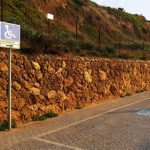Much of Istanbul is accessible or there is the attitude to make things accessible. Clearly, people and society have thought about the needs of the disabled. Folks normally have an accommodating response when asked for help.
NOTE: This visit was part of a ten-day, three-stop, tourist trip to Turkey in April of 2014. I had been to Istanbul once in 1980. And this was a chance to re-explore Turkey itself, and also see a modern and “safe” Muslim country. Please also see my review of Ephesus in Turkey.
ATTRACTIONS
Istanbul is a city of 14 million people that is over 2000 years old. On my five-day stop, I saw about half of the major tourist sites. On top of that list is the Hagia Sofia. The entry fee was waived and I got to cut the able-bodied line. This secular national park is perfectly flat with large smooth marble tiles. The part where some wheelchair users might have trouble is going over the thresholds of several doorways. The space is wide enough but the four thresholds to get fully inside are between 3” and 5” high. There are short wooden ramps laid down to assist, but they can be relatively steep, rickety, and the crown of the threshold is unevenly worn down. Once inside you are in one of the oldest largest buildings in the world. Awe-inspiring.
The Blue Mosque accommodates wheelchairs. There are limited visiting times for non-Muslims, and the timing never worked out for me to see the interior. I got as far as the inner courtyard. Be aware wheelchair visitors are required to transfer into a mosque wheelchair. The purpose is to protect the carpet that is hundreds of years old.
I toured the Grand Bazaar, and found that manageable. The pavement was smooth, and most small shops have level entryways. I saw signs for fully wheelchair accessible bathrooms but did not visit them. I visited Istanbul’s modern art museum, and it was gloriously fully modern. I visited the Naval Museum. It was fully ramped, but some ramps were steep and there were no elevators.
I dined under the Galata Bridge at one of the countless seafood restaurants there. I found a level path from the southern Golden Horn side. The north side is probably level too, but the route was getting too tortuous and I gave up.
There are a number of major sites that I did not see. Thus I cannot report on them. This includes the Topkapi Palace, and any boat cruise on the Bosphorous. The latter I guess would be like a ferry in the US—get on able, but after that, who knows… I also did not walk much around the Old Town in the Golden Horn. I am most familiar with the Galata neighborhood where my hotel was located.
GETTING AROUND
As an American wheelchair user, I often use New York City as my reference point for international or urban accessibility. Istanbul I suggest is much like NYC. In NYC, there are lots of modern accessible modern buildings and accommodation. But there is a legacy of the older way of doing things. In any neighborhood, street, or store, half of the elements might be accessible and half might have some kind of barrier. You can’t predict what exactly you will encounter, and you have to be flexible. “Walking around” is also a way of life. You cannot go from parking lot to parking lot like large of parts of the US to get around.
The main tramway that travels thru all the tourist sites is 100% accessible. There are no barriers, the fee is waived, and there is only the slightest 1” step into the roomy trains. Istanbul’s subway is like the subway in NYC and Chicago. There are US-standard accessible stations. However, they are gems in a system of older stations, which are not. I used the subway to visit Galatasaray FC’s football stadium and check out a pre-match scene. (I did have tickets, but there was a male ticket holder match ban for this game. This was due to bad behavior by Galatasaray fans in their preceding game.)
The 100-year-old funicular that ascends the steep Galata hill from the water is doable. It saves you from going up the hill. Again as a WC user, I didn’t have to bother with paying a ticket. I did not see or try the funicular that runs on the east side of Galata from Taksim Square to the Ottoman Palace on the water. Most buses do not seem to have lifts, and ordinary taxis are all sedans. Street traffic is rough and tedious for everyone so I don’t believe we are missing much.
ACCOMMODATION
I stayed at the Marmara Pera Hotel just off the European style walking street, Istiklal, in the Galata district. I used an accessible room, but it would not be perfect or ideal for everyone. The bathroom was spacious with a roll-in shower and roll-under sink. However, the bed area was quite narrow. I have a 26” wide chair and I do not think I could move between the beds. I crawled in from the foot of the bed. The breakfast area is accessed by an attractive individual lift from the lobby. The food spread was then up two steps, and the staff will eagerly throw down a wooden ramp and assist you when requested. I felt the hotel is well located for nightlife and transportation but inquire about the details at this place or others when looking for a hotel.




















